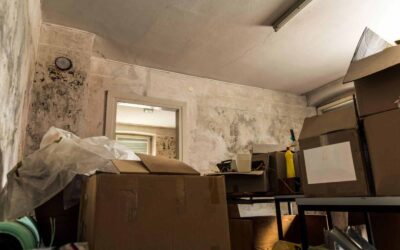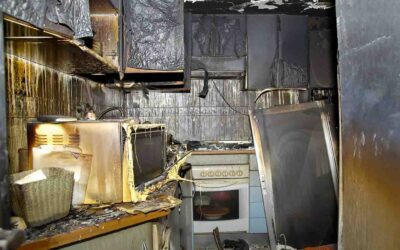Water damage can happen to any homeowner. You might experience flooding from severe weather, burst pipes, leaky roofs, or overflowing sinks, bathtubs, or toilets. Even just excess humidity in a damp basement or laundry room can cause damage. So, if you notice any unwanted water in your home, it’s vital that you clean it up as soon as possible and address the source of the water.
Unfortunately, your work doesn’t end there. Water damage may cause mold, which can become a serious secondary issue that is harmful to your home and your health. Mold can, of course, be removed, but preventing mold from water damage before it becomes a problem is the best-case scenario.
Knowing what to do when you experience water damage in your home puts you in a better position to protect yourself, your family, and your home from the harmful effects of mold. The following tips can help you be prepared and proactive when water damage occurs.
Quickly Dry Affected Areas
Did you know that mold can begin growing 24 to 48 hours after water has been introduced to a surface? That’s why it’s so important to begin the drying process as soon as possible. Remove as much excess water as you can, especially standing water, with whatever you have on hand. Towels, mops, rags, brooms (to sweep the water out), and a wet/dry shop vacuum are all good options. The sooner you can get rid of extra moisture, the better your chances of mitigating mold growth.
It’s important to touch surfaces to test for dampness since a visual inspection alone might not always be enough, especially with carpets or furniture where water might seep deep into fibers.
Use Dehumidifiers
Since mold thrives in moist environments, it’s essential to remove extra moisture from the air to prevent mold growth. When possible, relative humidity in your home should remain under 60 percent—30 to 50 percent is ideal.
Running dehumidifiers in affected areas can help pull moisture out of the air. This will speed up the drying process after water damage and make the environment less favorable for mold growth.
Ensure Proper Ventilation
Air circulation and proper ventilation can help prevent water damage from causing mold by accelerating the drying process, as the water evaporates more quickly, and reducing humidity and airborne pollutants like mold spores. Depending on the weather and climate, it might be helpful to open windows and doors to encourage airflow and create a cross breeze. Large box fans and ceiling fans should also be used to circulate the air in affected areas.
Consider Professional Help
If you have experienced extensive water damage, such as from burst pipes or a flood, it might be more than you can handle alone. You also might not be able to clean and dry wet areas enough to prevent water damage mold growth, especially if the water damage is in an area you don’t notice immediately, like the attic or crawl space.
When you’re unsure whether water damage has caused mold growth, start by having your home tested. The best practice is to choose a testing company outside of the remediation service you plan to use—or hire a remediation professional that utilizes a third party for testing. Professional testing will identify any hidden areas of mold growth or any unknown sources of excess moisture. Having peace of mind that your home is mold-free is invaluable.
If testing comes back positive for mold growth, hire mold remediation professionals to address the situation immediately. Working with a team of experts takes the guesswork and stress out of the process. They have the appropriate experience and tools to identify the underlying causes, contain the affected area, remove and dispose of materials that cannot be rescued, and thoroughly clean, disinfect, and restore the affected areas of your home, which reduces the risk of mold returning.
What To Do Moving Forward
Cleanup and mold removal are only part of the process after water damage causes mold growth. You must also take steps to avoid a repeat performance:
- Repair leaks and other plumbing issues: If the water damage came from a leaky pipe or roof, hire professionals to fix the damaged areas as soon as possible.
- Inspect and repair structural damage: Closely inspect drywall, flooring, and insulation for any signs of water damage. Repair or replace affected materials to avoid potential mold growth.
- Conduct regular checks: Kitchens, basements, bathrooms, and laundry rooms should all be inspected for leaks, humidity, and dampness on a regular basis. Remember to look under sinks as well.
- Purchase moisture sensors: There are many moisture and mold detectors available. Moisture sensors can alert you to moisture in unseen areas, such as behind walls, where moisture may otherwise be undetectable.
- Consider moisture-resistant flooring: If part of your home is prone to moisture, consider replacing carpeting or vinyl flooring with more moisture-resistant flooring, such as tile or concrete.
Get Help with Mold Removal and Remediation
The key to preventing mold growth is to take immediate action. The minute you notice signs of water damage (standing water, musty smells, peeling paint or wallpaper, discolored walls, high water bills, dripping sounds, dampness, warped flooring, etc.), you need to investigate thoroughly. Dry out the affected areas as completely and quickly as possible. Use dehumidifiers. Ensure proper ventilation. Finally, don’t hesitate to call professionals to help.
If you need mold removal and remediation services, contact Biodynamic. We specialize in mold removal and restoration for homeowners in Oregon and SW Washington, using cutting-edge, non-toxic products, tools, and equipment proven to be successful. In fact, 97 percent of our projects pass third-party exit testing on the first try. When you need the right solution to protect your home and your family’s health from the effects of water damage and mold, Biodynamic can help.


